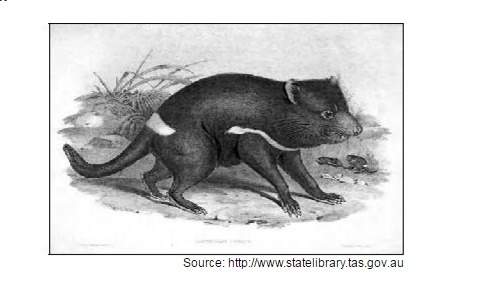
Biology, 14.01.2020 08:31 austinwilliams60
"the tasmanian devil is the largest surviving carnivorous marsupial in australia. it is in danger of extinction due to an unusual type of cancer called devil facial tumor disease (dftd). it can be passed from one individual to another through wounds that occur when they fight over food. tumor cells in the mouth of an infected animal break off and enter the wound on an uninfected animal. the tumor cells multiply in the body of the newly infected devil, forming new tumors that eventually kill the animal.
recent research has shown that the immune system of a tasmanian devil accepts tumor cells from another devil as if they were cells from its own body. the tumor cells are ignored by the immune system. no immune response develops against them, and the cancerous cells multiply. scientists predict that dftd could wipe out all the remaining tasmanian devils in 25 years, unless a treatment is developed.
using the terms antigens and antibodies, explain why the tumor cells are ignored by the immune system in tasmanian devils."


Answers: 2
Another question on Biology


Biology, 22.06.2019 03:00
To answer this question, researchers studied populations of the dusky salamander (desmognathus ochrophaeus) living on different mountain ranges in the southern appalachian mountains. the researchers tested the reproductive isolation of pairs of salamander populations by leaving one male and one female together and later checking the females for the presence of sperm. four mating combinations were tested for each pair of populations (a and b)—two within the same population (female a with male a and female b with male b) and two between populations (female a with male b and female b with male a). the proportion of successful matings for each mating combination was measured. for example, when all the matings of a particular combination were successful, the researchers gave it a value of 1; when none of the matings were successful, they gave it a value of 0. then the researchers calculated an index of reproductive isolation that ranged from 0 (no isolation) to 2 (full isolation). the reproductive isolation value for two populations is the sum of the proportion of successful matings of each type within populations (aa + bb) minus the sum of the proportion of successful matings of each type between populations (ab + ba). the table provides data for the geographic distances and reproductive isolation values for 27 pairs of dusky salamander populations.
Answers: 1

Biology, 22.06.2019 08:00
In a vegetable garden 45 bean plants have been eaten by deer 5 are untouched what is the frequency of bean plants in the garden that have been eaten?
Answers: 3

You know the right answer?
"the tasmanian devil is the largest surviving carnivorous marsupial in australia. it is in danger of...
Questions



Medicine, 26.11.2021 05:40


Geography, 26.11.2021 05:40





Mathematics, 26.11.2021 05:40

Computers and Technology, 26.11.2021 05:40

History, 26.11.2021 05:40


Mathematics, 26.11.2021 05:40

History, 26.11.2021 05:40

Mathematics, 26.11.2021 05:40



Mathematics, 26.11.2021 05:40

English, 26.11.2021 05:40



